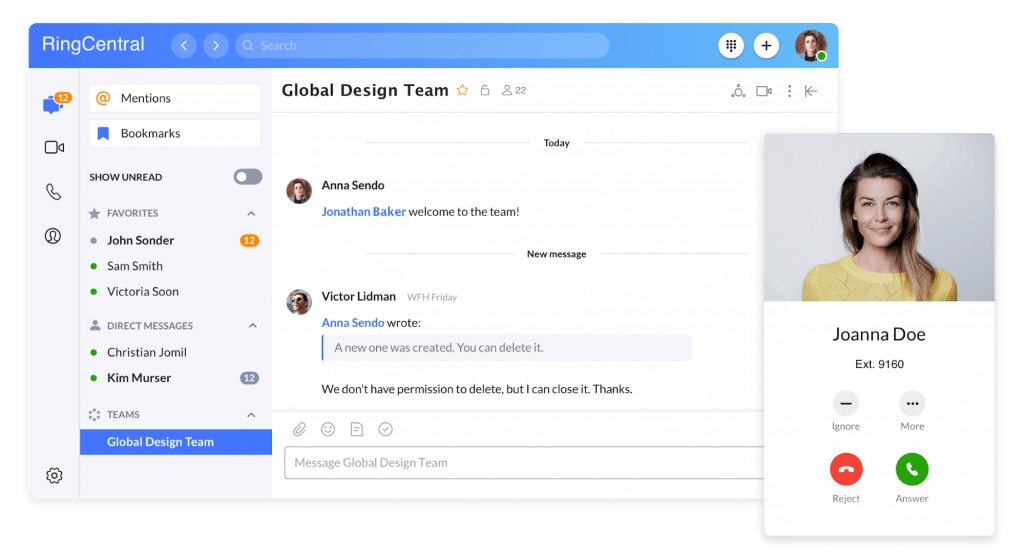Whether you have a large team that needs to meet every day (sometimes maybe even a few times every day) or you need to meet one on one with clients, conference calls are probably your go-to.
And if you’ve used a few conference call services before or done a decent amount of online shopping so far, you’ve likely come across “solutions” that overpromise and underdeliver.
Maybe it didn’t come with a mobile app. (Which is essential when so many businesses operate on the go these days.)
Maybe it charges you way too much for a tool that just does the bare minimum. (More on that later…)
Maybe you’ve found that for some reason, it doesn’t do the little things that make your life a lot easier (like integrating with your calendar app).
Some conference call services are just better suited for small businesses than others.
So what is the right tool for you? (And if you’re looking for something with video capabilities, we’ve compiled the best video conferencing software too.) Below, we’ll break down the top 12 conference call services for small businesses—and who should use each one:
- RingCentral
- Microsoft Teams
- Webex
- Join.me
- FreeConferenceCall.com
- UberConference
- Vonage
- Mitel
- Fuze
- ClickMeeting
- BlueJeans
- Lifesize
BONUS CONTENT: How to choose the right conference call service
🎧 Do you have the right headset equipment for your next conference call? Download this step-by-step buyer’s checklist to find out.
1. RingCentral
What is it?
Okay. So we might be a bit biased. But we did have a good reason for placing RingCentral at the top of the list.
For one, RingCentral is a convenient go-to platform for all things communication. Beyond just being a powerful conference call tool (which we’ll get to in a bit), RingCentral integrates traditional phone calls, video calls, and messaging all in one place—allowing you and your team to work in one communication tool and one communication tool only:
RingCentral’s conference call capabilities allow you to connect with up to 200 participants at once. If you want to turn your conference call into a video conference call, it also allows for screen sharing (so you won’t have to pay for an extra screen sharing software) and public and private chats.
This means your attendees can easily review documents and answer questions in the chat box—without interrupting the speaker.
Participants can join or host a meeting directly from their internet browser, so there’s no need to take up computer or phone space with another app download. Anyone can join instantly through the dial-in number provided in the invite. Plus, there’s a smart-switch feature that lets you switch between devices—start a meeting on your phone, and then switch to your computer once you’ve at your computer:
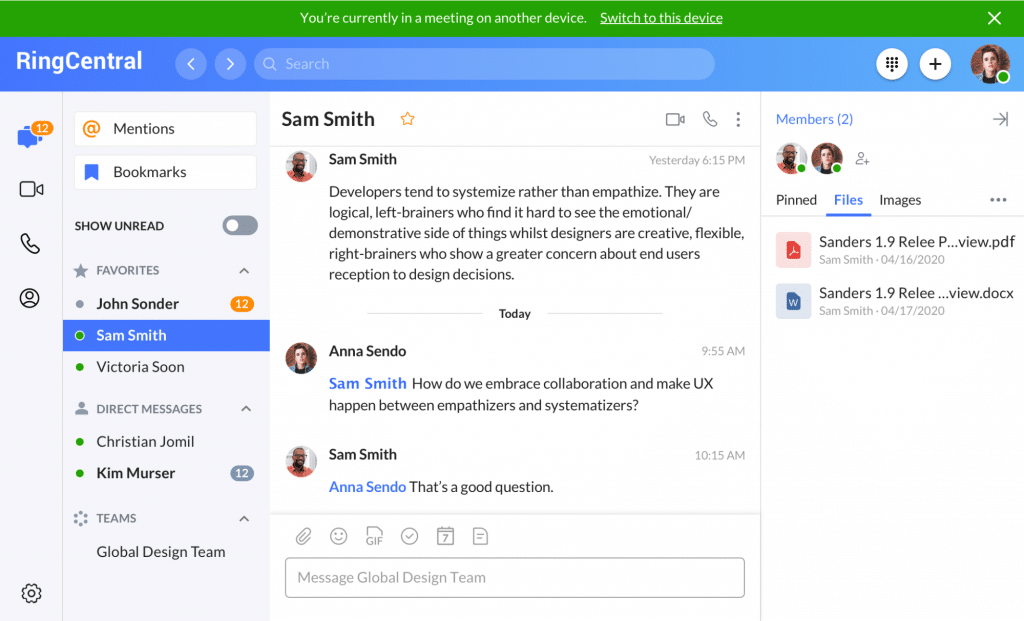
And meetings through RingCentral are secure too—just add an optional password to all your conference call meetings so you don’t have to worry about any uninvited guests. You can also use the Single Sign-on feature to allow your participants to quickly and easily log in to RingCentral using their company credentials (which reduces the time they have to spend typing out their passwords).
Because RingCentral creates an all-in-one workspace that’s basically a team collaboration hub, conversations can flow seamlessly both before and after a conference call. Using the team messaging feature, you can even follow up with attendees after a call with action items or notes:
What does it cost?
The cost of RingCentral depends on the number of users you have and how many features you’re looking for. At the time of this blog, plans begin at the “Essentials” level—$19.99 per user per month when billed annually. At this price point, you’ll have access to up to 20 users, business phone and toll-free numbers, team messaging, voicemail-to-text, and unlimited business SMS and calls within the US and Canada.
For added features, you can upgrade to the Standard plan for $24.99 per user per month when billed annually. This plan gives you an unlimited number of users and unlimited audio conferencing, and increases your possible meeting duration period to 24 hours (for those extra long meetings).
The most popular option, RingCentral Premium, gives you all the conference call bells and whistles starting at $34.99 if you’re paying annually. In addition to the unlimited conference call participants, Premium also has automatic call recording, advanced call handling (so you can coach your team while on a call), real-time analytics, and more.
With multiple pricing options, there’s something that fits your unique needs and budget.
RingCentral is a PCMag’s Editors’ Choice Award winner because of its reliable service and easy-to-use app (among other reasons)!
What customers say
RingCentral’s got some pretty happy small business customers using the conference call features, so we’ll let them take it from here:
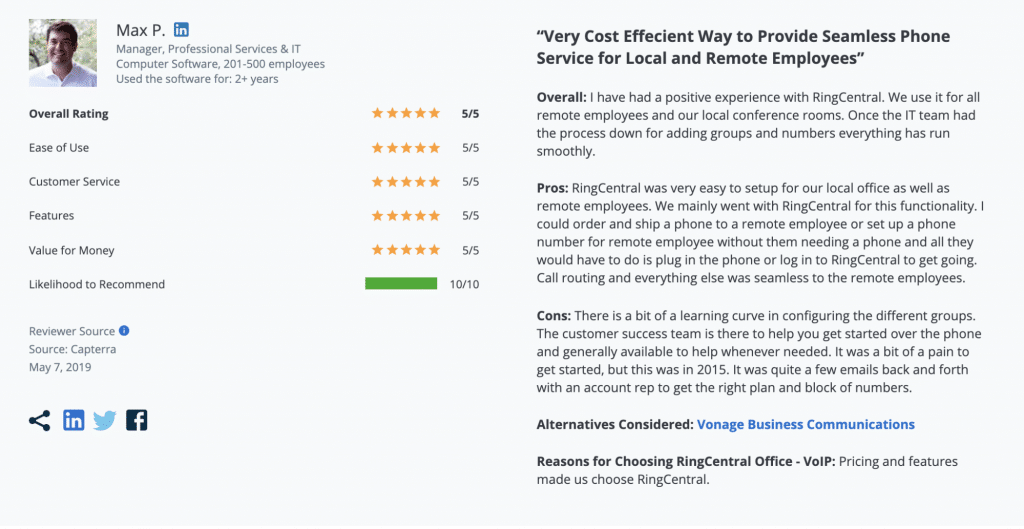
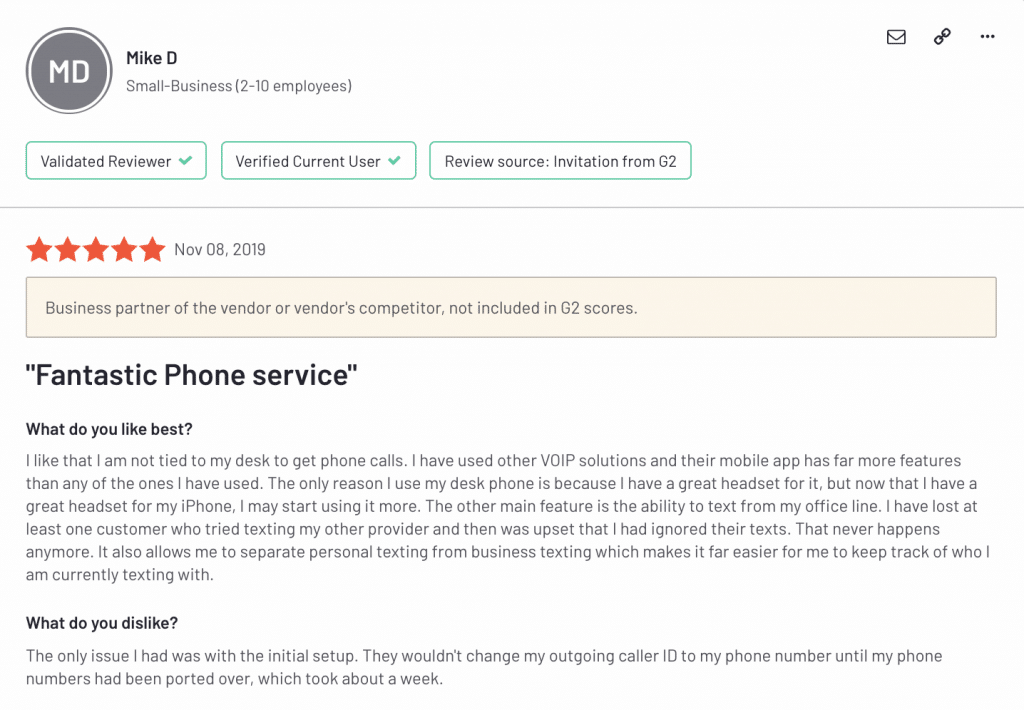
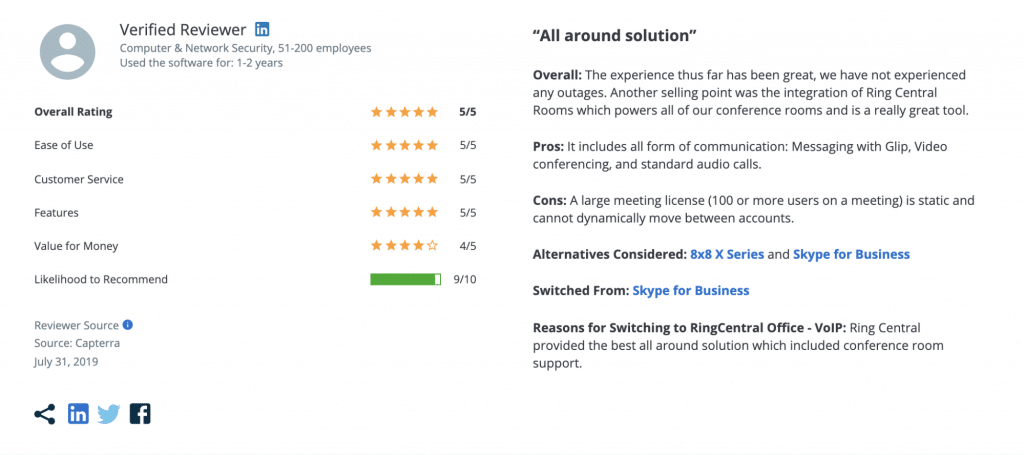
Best for small businesses that…
… want a conference call service that literally does it all, in one handy app.
🤯 On top of all this, RingCentral could save you up to $400 an hour in IT costs.
Explore the RingCentral Advantage for small businesses:
💰 You can also use this calculator to see roughly how much your business could save by using RingCentral to support your team’s communication with each other—and clients.
2. Microsoft Teams
What is it?
A few years ago, Skype was the go-to video conferencing service. Today, Microsoft has replaced Skype for Business with Microsoft Teams.
As the hub for communication for Microsoft 365 users, Microsoft Teams lets users easily transition between group chats and conference calls for quick collaboration, with a 250-participant limit.
Microsoft Teams treats audio and video calls the same, allowing for functionality of both depending on participant’s needs. However, if you are leading or planning the meeting, you’ll need a designated Audio Conferencing line—which will cost you $4 (whereas it’s included in RingCentral’s plans). When users sign up for Audio Conferencing, they’ll receive an automatically assigned toll-free number.
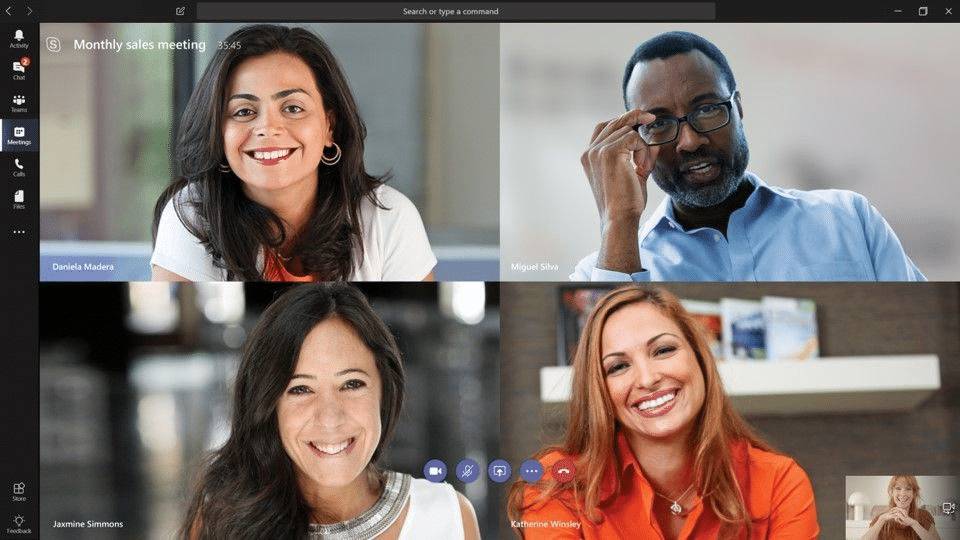
Microsoft Teams also has an AI feature to help filter out background noise from calls. Annoying noises like typing or dogs barking will be removed—meaning fewer participants need to toggle the mute button.
Best for small businesses that…
… already use the Microsoft 365 suite of apps.
3. Webex
What is it?
Webex is a conference call service from Cisco. It allows you to host webinars, webcast large-scale virtual events, learn online, provide remote customer support, or just have a one-to-one conversation with a team member.
Webex is another video-first platform with capabilities for audio-only calls. When you set up a meeting, a toll or toll-free dial-in number allows participants to join audio-only and a Call-Me feature lets the conference line call you directly, so you don’t have to worry about finding the right meeting number or password.
Because Webex is a video-focused conference call platform, many of its features relate to video chats. Like many of the other conference call tools on this list, Webex allows for screen sharing, chat, and connecting through video. These can come in handy if you’re meeting with a large group or you’re hosting a virtual event.
Premium plans also show participant information, including their business or job title, right in the call—perfect for if you’re speaking to large audiences at a time or if you’re working sales calls all day.
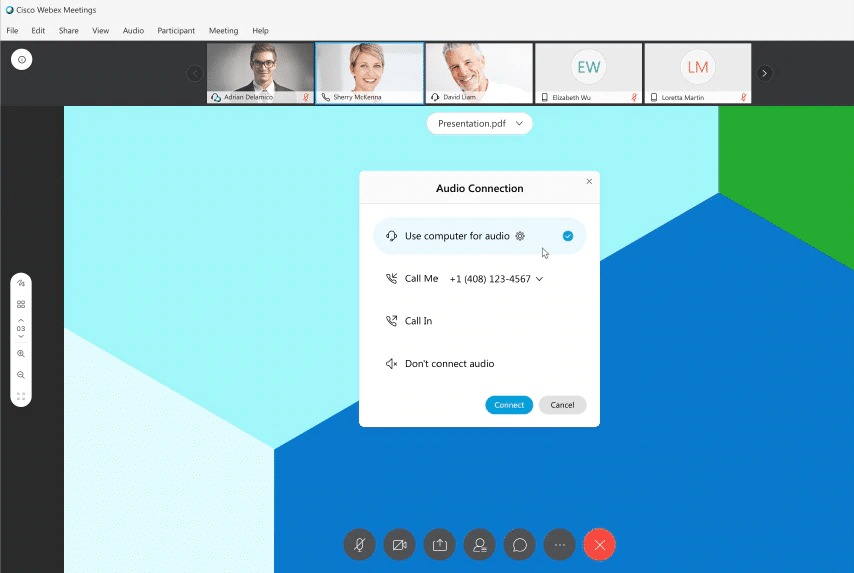
Webex has also recently introduced voice intelligence to Webex Meetings, which lets you use voice commands to enable AI-powered Webex Assistant to help with notes, meeting highlights, and follow-ups, and then share them with participants.
Best for small businesses that…
… are looking to host virtual events or larger conferences with participants outside of your company.
4. Join.me
What is it?
Join.me’s focus is on creating a simple platform for teams to communicate. Key word here is simple. By pulling back all the extra features that can make meetings harder to manage, Join.me is a simple, straightforward conference call service designed for everyday use.
Join.me offers video conferencing and audio conferencing features. Audio conferencing participants simply need to dial into a toll or toll-free number and enter a password while video participants can join without downloading any apps or software, making it easy for participants outside your business who may not use the app frequently to join.
Advanced audio features include local conference numbers in the US and 50+ countries, audio controls for meeting hosts, and the option to join by phone or internet.
With bridge audio conferencing, all participants can choose their favorite way to join, and everyone ends up on the same line.
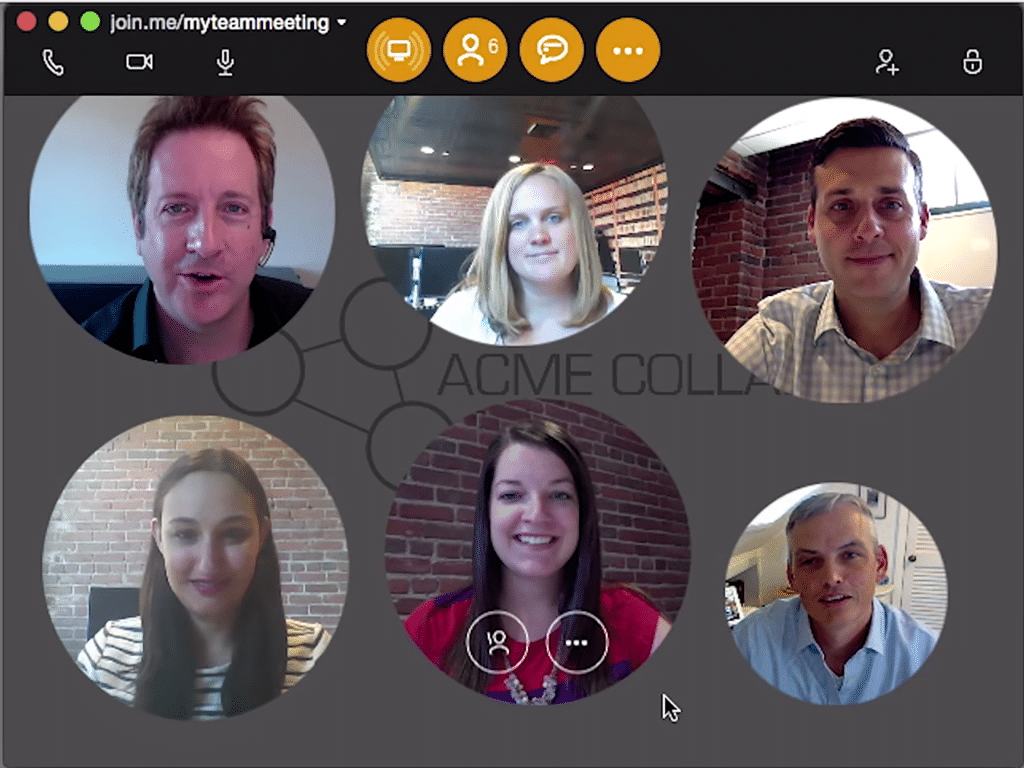
While Join.me might focus on simplicity, they do offer a whiteboard feature for iPhone and iPad users. With the whiteboarding tool, participants can follow notes, drawings, or even see your screen. Easily save your virtual whiteboard at the end of the meeting and send it to participants to refer back to.
Best for small businesses that…
… expect to do most of their conference calls through traditional audio calls.
5. FreeConferenceCall.com
What is it?
FreeConferenceCall.com is pretty straightforward—it’s a service that offers completely free conference call services. You’re able to host audio or video conferences for up to 1,000 participants.
While the platform is free, it still offers some of the more comprehensive conference features found in other premium services, including remote drawing tools, recording capabilities, private chat, and screen sharing.
But of course, it wouldn’t be free if it didn’t come with some limitations. If you choose to use the completely free version, you’ll have a pretty bare-bones experience. Storage is limited, so if you’re saving call recordings, you could run out of space pretty quickly. You also can’t offer toll-free call-in numbers, and you’ll need a new number for every call.
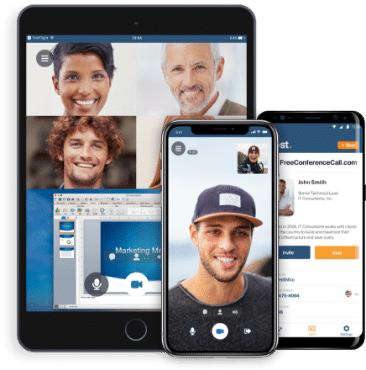
If these are deal-breakers for you, they do offer paid add-ons to create a better user experience. But of course, these additional features are à la carte, and you might end up paying less in the end even if you went with one of the other paid conference call services on this list.
Best for small businesses that…
… aren’t ready to commit to a monthly charge, but want a robust conference platform.
6. UberConference
What is it?
UberConference promises free video conferencing without PINs or app downloads—it’s a conferencing platform that lets attendees talk, video-chat, and screen share instantly no matter where they are.
As another video-first conference tool, audio calls come second to UberConference. However, they’re easy to use—especially if you’ll mostly just be connecting internally. With UberConference’s Instant Conference Call feature, you can start a conference just by dialing in to your UberConference number or sharing your UberConference URL.
One of their biggest selling points is their voice intelligence system. With built-in AI technology, UberConference provides a complete, searchable transcription of your meeting at the end of every call. This lets participants focus on the discussion at hand—and not worry about taking notes.
UberConference’s AI can even recognize action items. The platform auto-generates a report including the next steps, a link to the call’s recording, and other important details so there is less pressure on your team to create a follow-up plan. It’s already created for you:
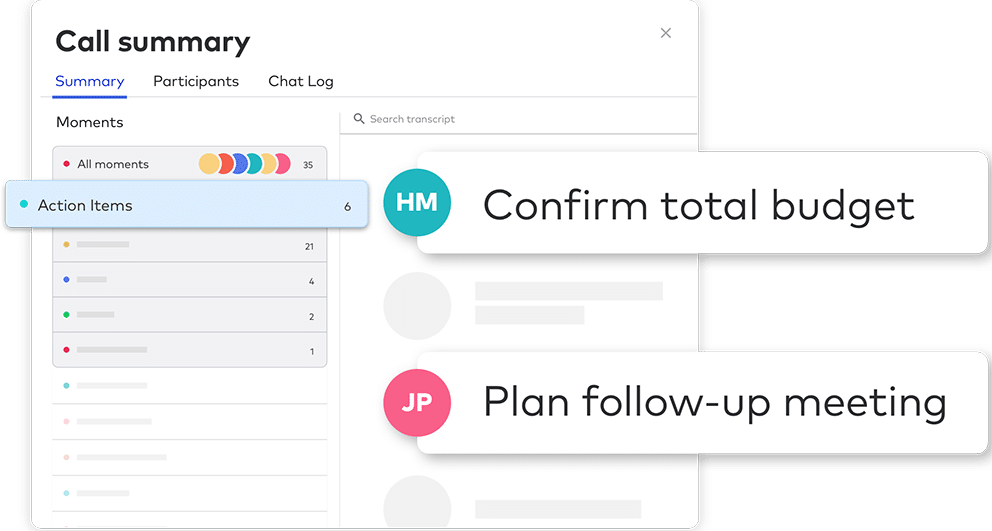
UberConference also has the ability to dial participants who might be running late or are having trouble joining. Rather than waiting for everyone to get on the call, you can dial that person during your call to bring them into the conference call.
Best for small businesses that…
… want to put note-taking and follow-up on autopilot.
7. Vonage
What is it?
Vonage is a business cloud communications provider, offering flexible and scalable voice, messaging, video, and data capabilities to small businesses and beyond. Their offering is broken down into three main areas: Communications APIs, Unified Communications, and Contact Centers.
Under their Unified Communications plan, Vonage offers multiple ways to hold a conference call. First, through their Conference Bridge feature, you can connect up to 30 participants with the push of a button. Just share a bridge number with participants, allow them to join, and then use the moderator dashboard to easily add or mute conference participants.
For smaller conversations, you can use their Call Conference feature, which comes at no extra cost with the Unified Communications plan. This only supports a three-way conversation, but allows you to easily add another person to a call already happening without needing to set up a new number and password.
Vonage has also recently introduced Vonage Meetings, a communication platform that allows team members to hold voice meetings, send SMS messages, and schedule group meetings all on one platform.
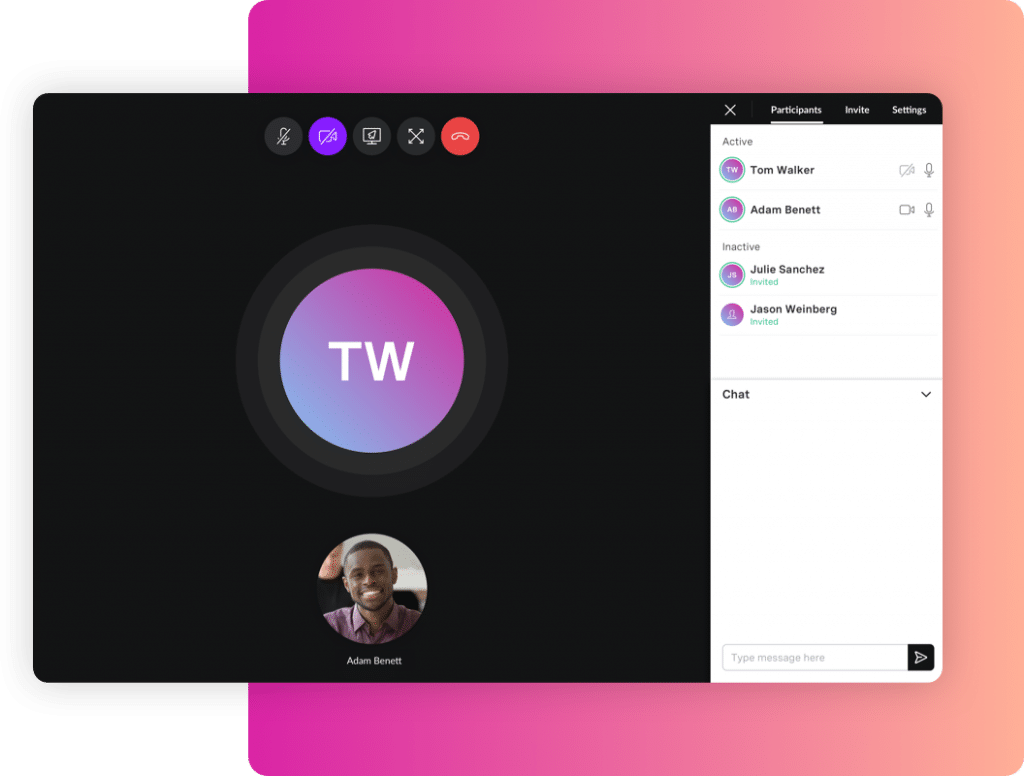
While Vonage stresses the benefit of flexibility in communication, their tools only work well for small groups or those that need to meet internally. With a 30 person limit on conference bridge calls, you can quickly max out that number if you have a large team or want to meet with multiple clients at once.
We did a deep dive on Vonage to compare it with the other best options on the market—check that out here.
Best for small businesses that…
… have small teams that want flexibility in how to connect internally.
8. Mitel
What is it?
Mitel’s MiCloud Connect platform is an easy-to-use, all-in-one cloud communications, collaboration, and contact center service that is built on Google Cloud, so it’s reliable, secure, and scalable.
Their collaboration tools include audio and video conferencing, which also allow for web-based collaboration viewing and sharing of files and screens. Meetings can be scheduled ahead of time or started on demand, including the ability to call out to participants for a more convenient call experience.
Participants can also join calls from a standard web browser to stream audio and view shared desktops, so no need to download applications before a call begins. This makes it easy for internal and external participants to attend calls on time and without additional headache.
Mitel’s conferencing features also include a raise-hand option that can prevent participants from talking over one another. This is particularly helpful for larger groups where multiple people may want to get a word in. With the raise-hand feature, your conference calls can run much more smoothly.
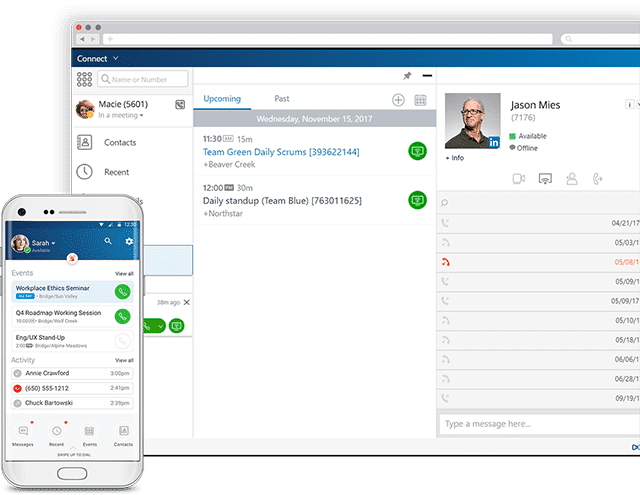
But the number of participants per call is limited. On the most basic plan, only eight participants can join an audio conference and only four for web conferencing with desktop sharing. If you need more than 25 participants on each call, you’ll need to buy into the Elite plan, which can be more than many small businesses want to spend.
Best for small businesses that…
… want the functionality of an office phone in a mobile app.
9. Fuze
What is it?
Fuze is an online meeting software and contact center that unifies voice, HD video calling and conferencing, integrated chat, and content sharing. By using a single application experience for both end users and admins, Fuze creates a seamless experience that allows everyone to get to work.
Fuze’s all-in-one platform puts your calls, meetings, and contact centers right in one place. Like standard PBX services, Fuze has basic features including call transfer, conferencing, parking, call recording, and voicemail. However, it also creates a localized experience in over 110 countries to act as a single consolidated voice carrier for distributed organizations.
For conference calls and meetings, Fuze has HD audio and video for meetings with up to 1,000 participants. Like other tools on this list, it offers dynamic screen and content sharing to take your meetings up a notch.
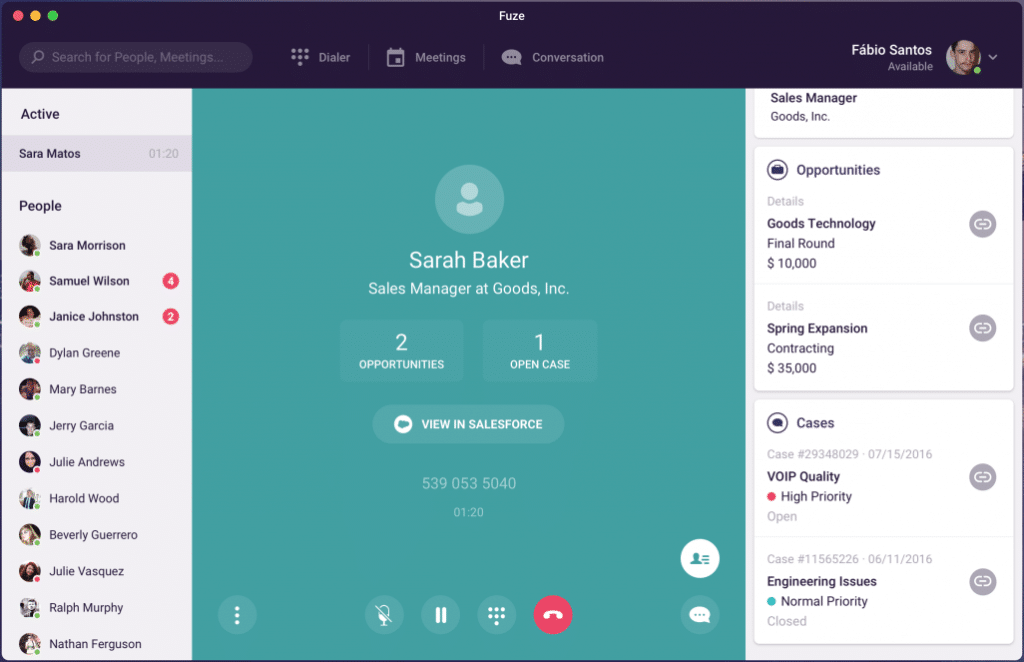
With Fuze, it doesn’t matter what device the participant uses to connect to the conference. It delivers consistent, high-quality voice, video, and content experience across all devices.
Best for small businesses that…
… want a consistent experience across devices and a platform that is easy to use.
10. ClickMeeting
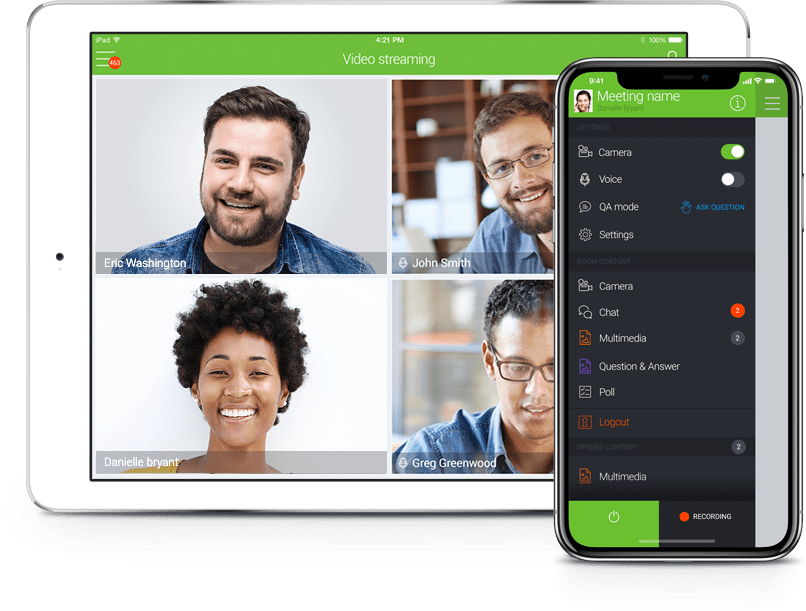
What is it?
From email marketing specialists GetResponse, ClickMeeting is a webinar tool that also enables you to conduct conference calls. Although it is a tool for conducting webinars first and foremost, ClickMeeting also comes with a set of useful and practical conference call tools, useful for keeping in touch and collaborating with coworkers.
However, it’s worth noting that because it’s primarily a webinar tool, the features it offers tend to be more focused on presenting insights (which makes sense, when you think about it). Nevertheless, it is flexible and highly customizable, and if you’re looking for a video conferencing tool that provides an interactive user experience, then ClickMeeting could be a good option.
As a collaboration tool, ClickMeeting has plenty to offer, and with its webinar capacities, it obviously offers something that potentially goes beyond video conferencing. Its prices start at $25 per month, billed annually. If you want to take it for a test drive, however, you can with a 30-day free trial.
Best for small businesses that…
…want an interactive, flexible conference tool that can also handle webinars.
11. BlueJeans
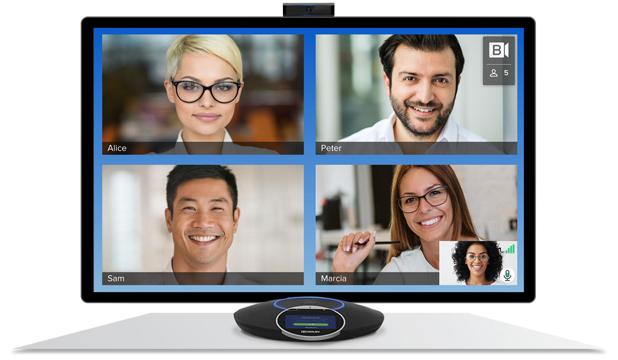
What is it?
Used by some of the biggest businesses and brands around—including Facebook and LinkedIn—Verizon’s BlueJeans is a video conferencing tool that offers exceptional audio quality. Audio really is king as far as BlueJeans is concerned, so if you want a conferencing solution where everyone can hear one another with razor-sharp clarity, this could be the one for you.
You might be wondering what the big deal is. Surely good audio quality is the least you’d expect from a modern video conferencing tool? Well, BlueJeans is powered by Dolby Voice technology, developed by audio experts Dolby Laboratories. Dolby specializes in audio encoding and noise reduction technology, which comes in handy here.
Dolby Voice is designed to minimize background noise while ensuring that the voice of each participant has a distinctive audio location. Making it all sound as if everyone on the call is located in the same room. Whether you’ve got a real foghorn of a voice or you’re as quiet as a mouse, you should have no trouble making yourself heard to the other participants.
With all that technology involved, you might be thinking that BlueJeans is way beyond your price range. Actually, this isn’t necessarily the case at all. In fact, BlueJeans plans start at $12.49 per month, with a participant limit of 50. You can also sign up for its upgraded plan, which will set you back $16.65 monthly, with up to 75 participants on conference calls.
Custom plans are available upon contacting BlueJeans, but there is one drawback. The maximum participant limit on offer is 150, which isn’t as accommodating as some other video conferencing solutions.
Best for small businesses that…
…want excellent audio quality along with affordability, and won’t need too many people in their video meetings.
12. Lifesize
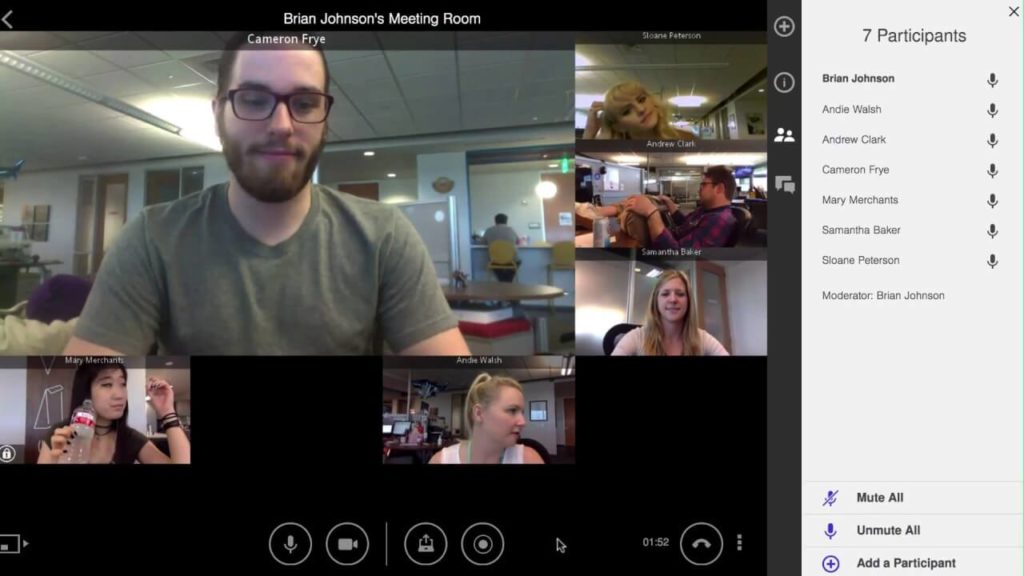
What is it?
For convenient and straightforward audio and video conference calls, Lifesize is a practical solution. It offers a range of handy features, including in-depth reporting on how employees are using the software, and the ability to save and share meetings with colleagues. There’s also its calendar integration tool, which allows you to adjust your calendar in the Lifesize app.
Lifesize provides excellent audio and video quality, a critically acclaimed app, diverse integration options, and numerous other useful features, as well as 24/7 customer support, just in case you need it. The only real downside here is that Lifesize’s chat tools are somewhat disappointing, so it’s up to you to decide how much that matters to you.
There are three paid plans and a free option, time-limited to six months. With Lifesize Free, you can have up to 25 participants with no duration limits (while it lasts). Lifesize Enterprise starts at $12.95 per month per host, with a minimum of 50 hosts. For this, you get unlimited US-only audio calling, 1,000-viewer livestream events, and premium support, among other things.
Best for small businesses that…
…want a reliable conferencing tool and aren’t too fussy about the quality of its chat functions.
How to choose the right conference call service
When it comes to choosing a conference call service that works best for your team, there’s no one-size-fits-all approach. Your needs will likely be different than your clients’, your vendors’, or even your competitors’ needs, so while it’s great to get recommendations on what is working for others, you’ll want to take a hard look at your unique needs before making a decision.
Here are some factors to consider when choosing a conference call service:
- Who is attending your calls? Are you connecting mostly internally or externally? How familiar will each attendee be with your platform and what will be expected of them on the call? How tech-savvy are your attendees?
- How many attendees are there? Are you looking to connect large groups, or are you mostly looking for one-to-one conference options? Will you need capacity for larger groups in the future?
- How often will you need a conference call line? Are your conference call needs short term, or are you looking for an investment? Can you commit to a year-long service, or do you need a month-to-month option?
- How much can you spend on a conference call line? What does your budget look like? Do you need the extra features that might hike the price of your service up, or do you only need a bare-bones option?
- How long are your conference calls? Can you get your meetings done in an hour or less, or are you looking to host day-long events?
- What do you need after a call? When you hang up, do you need call transcripts or recordings? Do you trust yourself to take detailed notes so you won’t forget any important details? Do you need video recording capabilities to share meetings with attendees or those unable to attend the call live?
- What additional features do you need? Are your calls more presentations than chatting? Do you need to be able to share screens, take control of an attendee’s computer virtually, or share notes with a virtual whiteboard?
What’s the best conference call service for you?
Before you invest in a conference call service, answer as many of these questions as possible. While you might not be able to find a service that checks all your boxes, prioritize the things that are most important to you.
Our biggest tip, whether you end up going with RingCentral or not, is to be realistic about what your business needs. There are tons of great free services out there, but they’re often aimed towards freelancers, personal users, or the occasional caller.
If you need something more robust or if you have a growing team, look at reasonably priced options that do multiple things well—you might end up paying less with a conference calling service that consolidates different functions into one!
Originally published Jan 02, 2021, updated Sep 26, 2024



